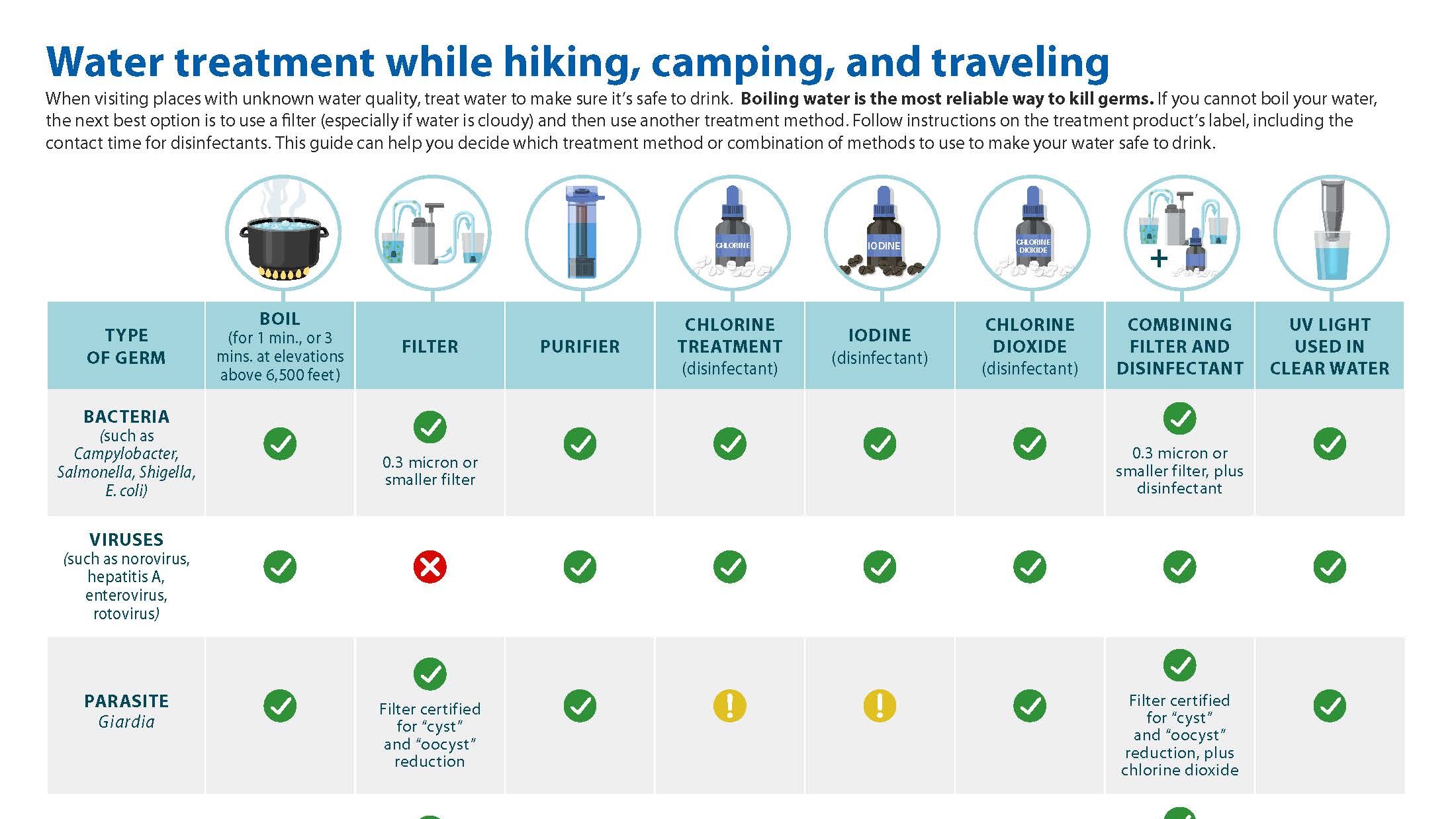Key points
- If you are not sure whether the water you are using is safe to drink, treat it to remove germs.
- Boiling is the best way to kill germs in water.
- The next best option is to filter water and then disinfect the filtered water.

Overview
You may not always know if the water you are using is safe to drink, especially when hiking, camping, or traveling.
In these cases, boil your water or use other treatment methods to remove germs before using the water.
Exposure
Germs from human or animal poop can get into water, such as lakes, rivers, or streams. You can get sick from swallowing water that has not been treated to remove germs. For example, you can get sick by using it to:
- Drink
- Cook
- Wash fruits and vegetables
- Make ice or drinks
- Brush your teeth
In places without sanitation and water treatment infrastructure, water is more likely to have germs that can make you sick. These places can include:
- Campgrounds
- Hiking areas
- Remote areas
- Locations within and outside the United States where water is not treated
Clear water can be unsafe
Water containing germs that can make you sick—including bacteria, viruses, and parasites—sometimes looks clean. Drinking water straight from a clear mountain stream is generally not safe, for example.
Who is at risk
Anyone can get sick from drinking unsafe water.
Those at higher risk of getting sick include:
- Children
- Pregnant women
- People 65 years or older
- People with a weakened immune system
Symptoms
Common symptoms caused by drinking unsafe water when hiking, camping, or traveling include:
- Diarrhea
- Vomitting
- Stomach pain
Prevention steps and strategies
Treating your water, burying your poop if toilets are not available, and washing your hands can help you avoid getting and spreading germs.
Treat your water
Boiling water is the best way to kill germs that could make you sick. The next best option is to filter water and then disinfect the filtered water.
Follow the instructions on any products you use to make sure they work properly to remove germs.
Do not drink water contaminated with harmful chemicals
Boil

To kill germs, bring clear water to a rolling boil for 1 minute. At elevations above 6,500 feet, boil for 3 minutes. To avoid burns, allow the water to cool before using it.
When traveling to places with electricity, consider bringing a small heating coil or beverage warmer to boil water.
Filter

A filter labeled with either of the following will remove parasites, but not viruses or all bacteria:
- Absolute pore (hole) size of 1 micron or smaller
- Certified for NSF standards 53 or 58 for cyst reduction or removal
A filter with an absolute pore (hole) size of 0.3 micron or smaller will remove bacteria and parasites, but not viruses.
Reverse osmosis filters remove parasites, bacteria, and viruses. They also remove salt from water.
Disinfect

You can kill bacteria and viruses in water using disinfectants such as unscented household chlorine bleach, iodine, or chlorine dioxide tablets.
Filter water before disinfecting it. Chlorine bleach and iodine kill bacteria and viruses but do not work well to kill parasites. Chlorine dioxide tablets can kill the parasite Giardia and are somewhat effective at killing Cryptosporidium. However, it is still safest to filter the water first to remove these parasites.
Using UV light

Portable units that deliver ultraviolet (UV) light can kill parasites, bacteria, and viruses in small amounts of clear water.
Filter water before using UV light. UV light does not work well in cloudy water because small particles can block germs from the light.
Using MIOX® systems
MIOX® systems use a salt solution to create a mix of chemicals, primarily chlorine. Chlorine kills viruses and bacteria but does not work well to kill parasites.
Bury your poop
If you are in a remote area without toilets, bury your poop to keep it from getting into water. Aim to bury your poop deep in the soil, at least 8 inches, and at least 200 feet away from lakes, rivers, and other natural waters. Make sure to bury poop downstream from where you or others collect water.
Wash your hands
Wash your hands before handling food, eating, and after using the toilet. If soap and water are not available, use a hand sanitizer that contains at least 60% alcohol.

